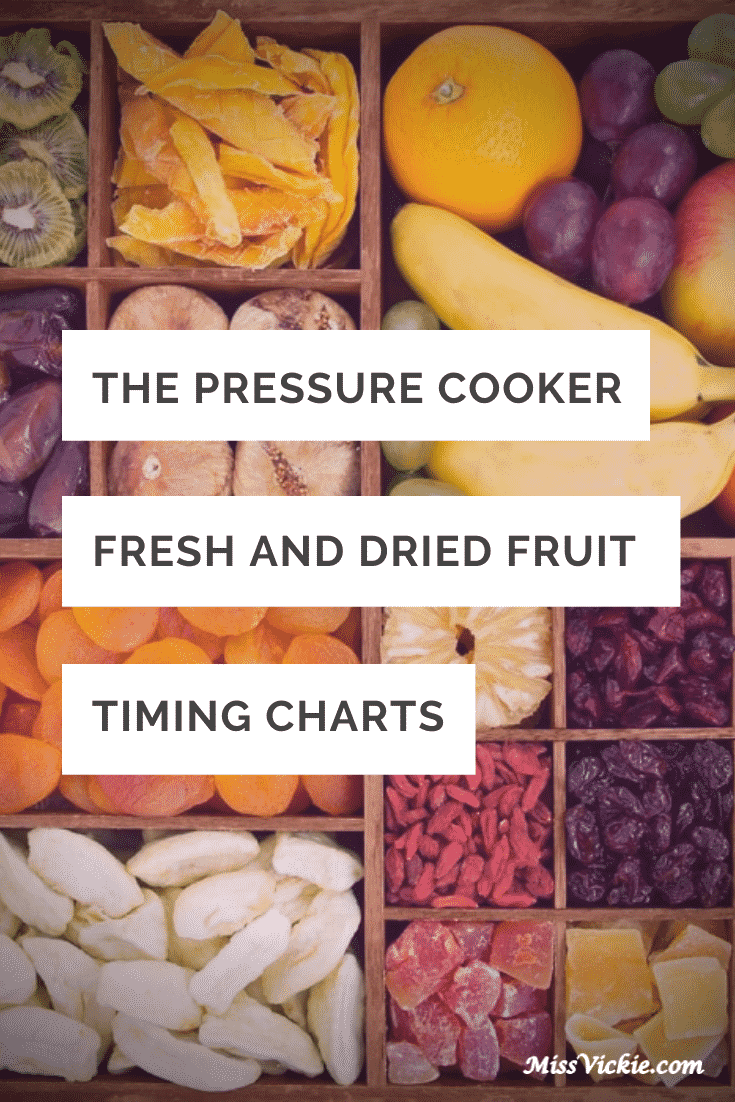
Pressure cookers are excellent for preparing delicious meals in a hurry and fresh and dried fruit is no different. You can prepare virtually any meal on a pressure cooker, and not just meats and main courses. Pressure cooking allows you to cook foods a lot faster than most conventional methods that you may have been used to. Additionally, pressure cooking enables you to save valuable time, energy and nutrients so that you can make the most out of your meals.
Pressure cookers are great for preparing time consuming fruit dishes such as jams which often require hours of simmering. The pressure cooker allows fruit to breakdown a lot more easily even when dealing with resistant bases such as pear and apples. When using a pressure cooker, the heat remans low so that all the fruit juices do not escape, which eliminates any need of you adding excess sugar or other harmful additives at the end. When preparing fresh and dried fruit with your pressure cooker, here are some things that you need to consider:
Follow instructions
If you are preparing a dish containing more than one variety of fruit, you should bear in mind that the stage of ripeness of the fruits in question, the size of the fruit chunks that you are using, as well as the quality of your fruit will impact the timing. When dealing with fruit, cook it for the minimum time listed on the recipe so that the fruit can reach the desired tenderness for the best results.
Try not to fill your pressure cooker to capacity
Generally, you should avoid filling up your pressure cooker to the brim. You should never pack your fruits too tightly or more than two thirds way full as it could affect the results that you are expecting. If you fill up the pressure cooker with too much fruit, it could also cause safety issues that such as activated safety valves.
As with veggies, always wash your fruit thoroughly before placing them on the steamer basket. For fresh fruits, consider using about a half a cup of water while dried fruit will do well with a cup full of water. Be sure to consult your user manual to determine the exact quantity of water that you need to use for your pressure cooking meals.
Steam works best
Just like preparing frozen or fresh veggies, fresh and dried fruits are best when steamed so as to preserve the texture, nutrients, minerals and the taste of the fruits. Steaming your fresh and dried fruits also allows you to maintain the natural colour and look of the fruit, which is essential for any fruit dish you are preparing.
Always set a timer
When preparing dried and fresh fruits, always have a kitchen timer handy so that you keep track of the cooking time specified by the recipe. If you are using an electric pressure cooker, it will already come with a digital timer built in that will help you maintain the right cooking time.
Release the pressure when done
When you are done preparing your dried or fresh fruit under pressure, be sure to use an appropriate pressure release method depending on the recipe that you are using. As always, you should avoid attempting to use the cold-water release method, especially when working with electric pressure cooker. Not only is the cold-water release method complicated and complex to follow, but it can also potentially shorten the lifespan of your pressure cooker.
Pressure Cooker Fresh And Dried Fruit Timing Charts
| FRESH AND DRIED FRUIT | COOKING TIME | LIQUID |
|---|---|---|
| Apples, fresh, slices or chunks | 2 to 3 minutes | 1/2 cup |
| Apples, slices, dried | 2 minutes | 1/2 cup |
| Apricots, dried | 4 minutes | 1/2 cup |
| Apricots, fresh, halved | 2 minutes | 1/2 cup |
| Bananas | 0 minutes | 1/2 cup |
| Berries, fresh | 0 minutes* | 1/2 cup |
| Blueberries | 2 minutes | 1/2 cup |
| Cherries, fresh | 0 minutes* | 1/2 cup |
| Cranberries, dried | 5 minutes | 1/2 cup |
| Cranberries, fresh | 4 to 5 minutes | 1/2 cup |
| Dates | 10 minutes | 1/2 cup |
| Figs | 6 minutes (10 minutes = tough skinned varieties) | 1/2 cup |
| Grapes, for jelly making | 1 minute | 1/2 cup |
| Lemons | 2 minutes | 1/2 cup |
| Oranges | 2 minutes | 1/2 cup |
| Peaches, dried | 4 minutes | 1/2 cup |
| Peaches, fresh, halved | 3 minutes | 1/2 cup |
| Pears, dried | 4 minutes | 1/4 cup |
| Pears, fresh, halved | 3 to 4 minutes | 1/2 cup |
| Pears; whole | 8 minutes | 1/2 cup |
| Pineapple; slices | 6 minutes | 1/2 cup |
| Plums, fresh | 0 minutes* | 1/2 cup |
| Prunes | 5 minutes | 1/2 cup |
| Quince, fresh, quartered | 5 minutes | 1/2 cup |
| Raisins | 5 minutes | 1/2 cup |
| Raspberries | 1 minute | 1/2 cup |
| Strawberries, for jelly making | 1 minute | 1/2 cup |
* Bring to high pressure, remove from the heat, and lower the pressure immediately using the cold-water-release method.
Table by Miss Vickie Smith